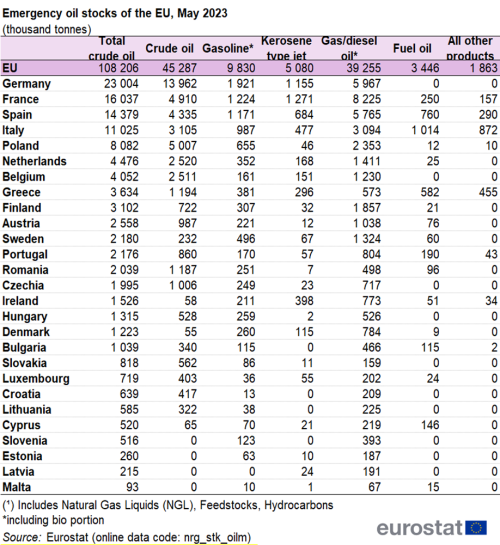Emergency oil stocks statistics
Data extracted 18 October 2023
Planned article update: October 2024
This article presents data on emergency and commercial oil stocks in the European Union (EU). Crude oil and petroleum products play a very important role in the economy of the European Union and, given the oil import dependency of the EU, holding emergency oil stocks is very important for the energy security of the EU. Commercial stocks can also be fundamental in times of need and therefore are included in the assessment of the overall stock holding situation. Given the current geopolitical instability, holding stocks becomes even more crucial.
Full article
Emergency oil stocks statistics
Crude oil and petroleum products play a very important role in the economy of the European Union, particularly in the transport sector and the petrochemical industry. Given their important role and the oil import dependency of the EU, holding emergency oil stocks is very important for the energy security of the Union. To guarantee these stocks, the relevant EU law, Council Directive 2009/119/EC imposes an obligation on Member States to maintain minimum emergency stocks of crude oil and petroleum products. Member States are required, at all times, to maintain oil stocks equivalent to at least 90 days of average daily net imports or 61 days of average daily inland consumption, whichever of the two quantities is greater. In the geopolitical situation following the Russian aggression on Ukraine, these requirements have played a major role in stabilising the market as they did previously during other lesser emergencies.
The EU emergency oil stocks
Table 1 presents the emergency oil stocks of each EU Member State as well as of the European Union. In May 2023, the EU held 108.2 million tonnes of emergency oil stocks, an increase of + 7.2% from June 2022, a month that recorded the historical low of 101.1 million tonnes, marking a decrease of -4.5% from the beginning of 2022 and of -10.3% from June 2021.)
June 2022 levels reflect two emergency oil stocks releases coordinated by the International Energy Agency (IEA) in March and April 2022. The total amount released of 182.7 million barrels was the largest in the IEA’s history (see here). Eighteen EU Member States participated in the joint action and released stocks in the course of the following months. The current levels are mostly composed of crude oil (45.3 million tonnes in the EU), followed by gas/diesel oil (39.3 million tonnes) and gasoline (9.8 million tonnes). The composition of the emergency stocks by fuels is selected by each country and must adhere to its specific needs; therefore, it varies as seen in the table below.
Some of the EU Member States that participated in the coordinated effort of stabilising the oil market, or used stocks to face internal difficulties assuring supply to final customers, fell below their required levels which were in force between June 2021 and June 2022, and were based on the production and imports data of 2020.
Furthermore, new requirements, based on 2021 data, took effect as of July 2022. In the majority of Member States, the annual needs in 2021 exceeded those in 2020, a year marked by particularly low demand due to the Covid crisis. This widened the disparity between the held and required stock levels, starting from July 2022. Up until June 2022, the minimum stock level for compliance in all EU countries was 86.3 million tonnes, which was subsequently raised to 90.3 million tonnes in July 2022.
Member States are obliged to replenish the stocks to the minimum required levels and cooperate with the Commission to determine a reasonable time frame, taking into account the situation in the domestic and international oil and petroleum products markets.
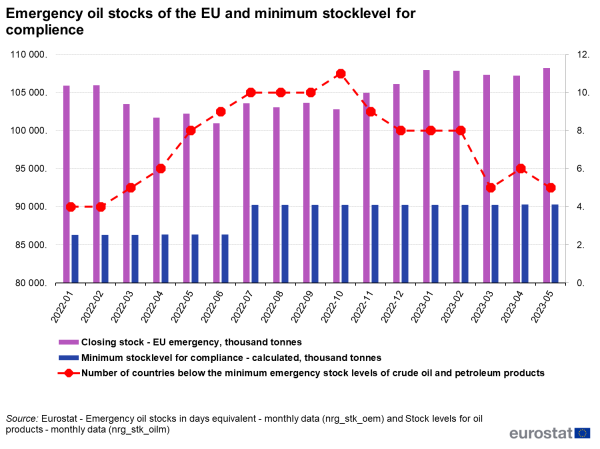
Source: Eurostat nrg_stk_oilm
Emergency oil stocks in days equivalent
Stocks requirements are expressed in “days equivalent” as Member States must maintain, at all times, oil stocks amounting to at least 90 days of average daily net imports or 61 days of average daily inland consumption, depending on which of the two quantities is greater. The 90 days net imports method generally applies to Member States who are heavily import dependent. The 61 days inland consumption method normally applies to Member States that produce crude oil and oil shale and for which domestic production contributes mostly to their security of supply. The inland consumption method can also apply to Member States with very significant petrochemical industry, such as the Netherlands.
The reference method for requirements are subject to change in July of each year when the obligations are recalculated based on the production and import/export data from the preceding year. In July 2022, Estonia's obligations shifted from being based on 90 days of average daily net imports to 61 days of average daily domestic consumption. Estonia is the only country for which the method for calculating requirements changed.
Table 2 presents the emergency oil stocks in days equivalent, according to the methods applied for the obligations. In January 2022, before the coordinated releases mentioned above, 24 Member States kept oil stocks based on net imports and four were below the 90 days requirement (marked in red below). Two Member States kept stocks based on inland consumption and both were above the required 61 days.
In October 2022, the number of Member States falling below the requirements increased to eleven. This drop below requirements was primarily attributed to two emergency oil stock releases and due to the increased in the requirement levels. Starting in October 2022, countries began steadily increasing their stock levels. By May 2023, only 5 countries still remained below the required level.
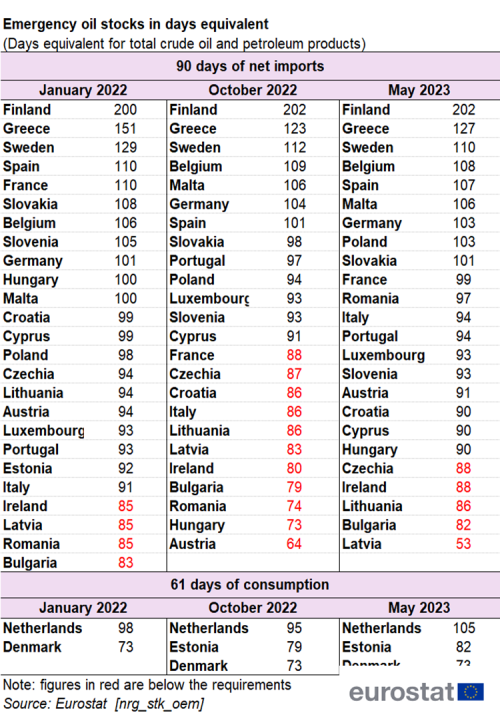
(in days equivalent)
Source: Eurostat nrg_stk_oem
Emergency oil stocks held abroad
Member States can hold their emergency oil stocks in their own territory or in other EU Member States. In May 2023, 11.3 % of emergency stocks in the EU were held in other Member States. National procedures differ very much in this regard. Five Member States kept all their emergency stocks in their territory: Czechia, Hungary, Austria, Poland, Slovakia, while 22 Member States held part of their emergency stocks in the territories of other Member States. The country with the biggest share of oil stocks held abroad was Luxembourg (87.0 %), followed by Malta (84.4 %) and Belgium (49.1 %). Data can be seen here: Eurostat nrg_stk_oem
Commercial stocks
According to the Directive, countries must also report most of their commercial stocks. Specifically, they must report those stocks held by economic operators in the national territory for their own operational and commercial needs, which therefore can be considered available, in addition to the emergency stocks, in case of need.
However, while emergency stocks, outside critical events, are normally quite stable as they reflect obligations that are calculated on an annual basis, commercial stocks in the territory may fluctuate according to market trends.
In August 2020, due to reduced demand for various fuels during the Covid crisis, commercial oil stocks reached a historic high of 63.2 million tonnes, with some countries even reaching their maximum storage capacity limits.
Subsequently, as economic activities resumed, commercial stock levels began to decline and reached a low point in December 2021, totaling 44.8 million tonnes. Starting in January 2022, efforts to replenish commercial stocks commenced. However, the situation shifted once again due to the Russian invasion of Ukraine. In the following months, the market experienced significant instability, causing fluctuations in commercial stocks, which stood at 52.9 million tonnes in May 2023. During that month, commercial stocks accounted for 32.8% of the total stocks reported under the Directive.
These values are intrinsically volatile, as they are influenced by many factors such as spot prices, geopolitical situations, OPEC+ decisions, policy announcements, and refineries’ choices.
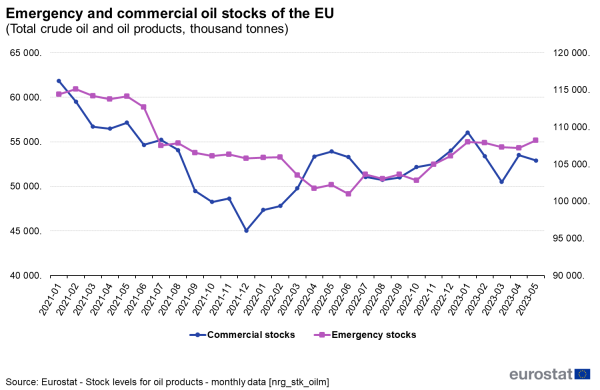
Source: Eurostat nrg_stk_oilm
In May 2023, the Member States with the largest quantity of commercial stocks were the Netherlands (9.7), Germany (9.3 million tonnes) and Italy (5.6). Followed by France (4.3) and Belgium (3.4).
The proportion between commercial stocks and total stocks were highest in Netherlands (68.4 %), Hungary (62.5 %), Croatia (58.2 %) and Sweden (58.2 %), followed by Malta (56.8 %).
Figure 3 shows both emergency and commercial stock levels in the different EU Member States.
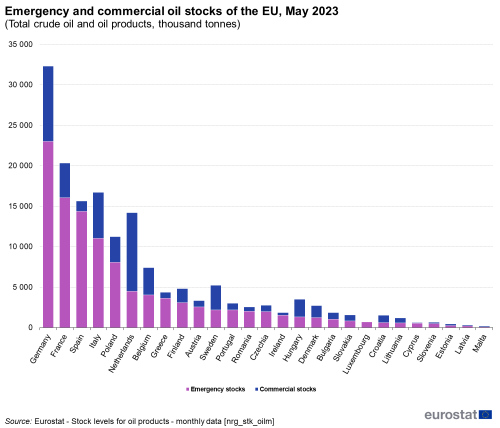
(Total crude oil and oil products, thousand tonne)
Source: Eurostat nrg_stk_oilm (Total crude oil and oil products, thousand tonne)
Source data for tables and graphs
Data sources
Data on energy are submitted on the basis of internationally agreed methodology. Data are available for all EU countries and the methodology is harmonised for all reporting countries. Consequently, data comparability across countries is very high. All energy data are available in the online database.
NOTE: Some data are provisional: Please refer to the “p” flags in the database for further details.
NOTE: Quantities of emergency stocks held in accordance with the Directive listed as “Stocks – EU Emergency” in table NRG_STK_OILM refers to actual quantities in thousand tonnes. Such quantities are reassessed using weights (multipliers) to determine their value in “days equivalent” which are reported in table NRG_STK_OEM.
Yearly imports and consumption values declared by reporting countries are also reassessed using weights (multipliers) to calculate requirement levels defined as “minimum stock level for compliance” in table NRG_STK_OEM.
This can create some apparent discrepancies when comparing values in NRG_STK_OILM NRG_STK_OEM
Council Directive 2009/119/EC details the provisions regarding these weights.
Context
Crude oil and petroleum products play a very important role in the economy and import dependency is a very crucial element of economic stability, political autonomy and energy security. Holding emergency oil stocks is therefore very important in time of crises. The assessment of the overall stock holding situation is consequently a fundamental task. Requirements and obligations for the EU Member States are outlined in the Council Directive 2009/119/EC of 14 September 2009 imposing an obligation on Member States to maintain minimum stocks of crude oil and/or petroleum products and in the Commission Implementing Directive (EU) 2018/1581 of 19 October 2018 amending Council Directive 2009/119/EC as regards the methods for calculating stockholding obligations
Direct access to
Database
Dedicated section
Methodology
